高速铁路优势-英语作文
- 格式:doc
- 大小:13.50 KB
- 文档页数:2
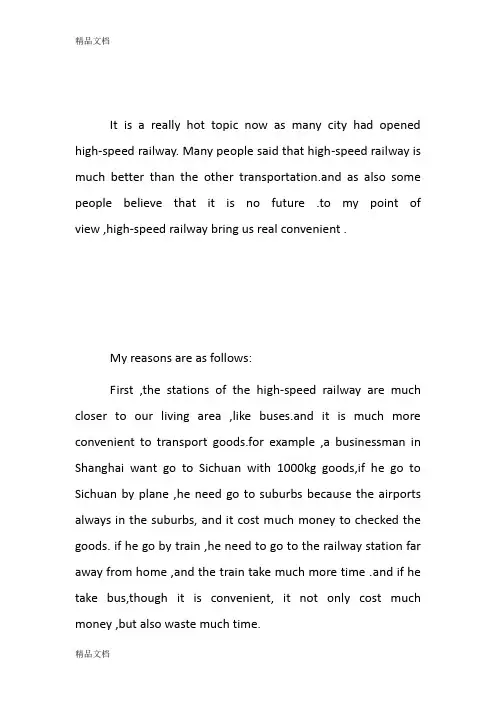
It is a really hot topic now as many city had opened high-speed railway. Many people said that high-speed railway is much better than the other transportation.and as also some people believe that it is no future .to my point of view ,high-speed railway bring us real convenient .My reasons are as follows:First ,the stations of the high-speed railway are much closer to our living area ,like buses.and it is much more convenient to transport goods.for example ,a businessman in Shanghai want go to Sichuan with 1000kg goods,if he go to Sichuan by plane ,he need go to suburbs because the airports always in the suburbs, and it cost much money to checked the goods. if he go by train ,he need to go to the railway station far away from home ,and the train take much more time .and if he take bus,though it is convenient, it not only cost much money ,but also waste much time.Secondly,the most important disadvantage of high-speed railway is that it need a great number of passengers .As the second most populous countries of the world, Chinese has no pressure.What's more ,China is developing in a "high speed",even though high-speed railway cost much money , I believe China can hold it .As all above ,I firmly believe that the future of high-speed railway is shinning!。
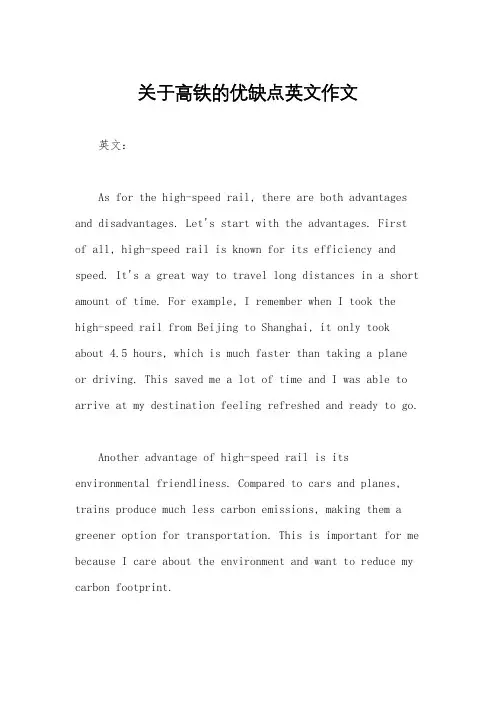
关于高铁的优缺点英文作文英文:As for the high-speed rail, there are both advantages and disadvantages. Let's start with the advantages. First of all, high-speed rail is known for its efficiency and speed. It's a great way to travel long distances in a short amount of time. For example, I remember when I took the high-speed rail from Beijing to Shanghai, it only took about 4.5 hours, which is much faster than taking a plane or driving. This saved me a lot of time and I was able to arrive at my destination feeling refreshed and ready to go.Another advantage of high-speed rail is its environmental friendliness. Compared to cars and planes, trains produce much less carbon emissions, making them a greener option for transportation. This is important for me because I care about the environment and want to reduce my carbon footprint.In addition, high-speed rail can also stimulate economic development. For instance, the construction of high-speed rail lines can create jobs and boost local economies. It also makes it easier for people to travel for work or leisure, which can benefit businesses and tourist destinations along the rail routes.Now, let's talk about the disadvantages of high-speed rail. One of the main drawbacks is the high cost of construction and maintenance. Building and maintaininghigh-speed rail lines requires a significant investment of resources and money. This can be a burden on the government and taxpayers.Furthermore, some people argue that high-speed rail is not as convenient as other forms of transportation. For example, the stations are often located outside of city centers, so passengers have to spend extra time and money to get to and from the stations. This can be a hassle, especially for those who are traveling with a lot of luggage or have limited mobility.Lastly, there are also concerns about safety and security on high-speed trains. Although accidents are rare, the high speeds at which these trains travel can pose arisk in the event of a mishap. This is something that makes some people hesitant to choose high-speed rail as their preferred mode of transportation.Overall, high-speed rail has its pros and cons, andit's important to weigh them carefully when considering whether to use it for travel.中文:关于高铁,它既有优点也有缺点。

高铁的优点与影响英语作文High-speed rail, also known as bullet train, hasgreatly improved the efficiency of transportation. It can reach a speed of over 300 km/h, which greatly shortens the travel time between cities.The construction of high-speed rail has created a large number of job opportunities for local residents, which has promoted the economic development of the surrounding areas.High-speed rail is environmentally friendly, as it reduces the reliance on air and road transportation, which helps to decrease air pollution and traffic congestion.The operation of high-speed rail has brought convenience to people's travel, making it easier for them to visit friends and relatives in different cities.The development of high-speed rail has also boosted the tourism industry, as it allows tourists to travel tovarious destinations quickly and comfortably.The introduction of high-speed rail has led to the revitalization of the railway industry, as it requires advanced technology and equipment, which promotes the development of related industries.The construction of high-speed rail has improved the overall transportation infrastructure, which hasfacilitated the flow of goods and people, contributing to the economic growth of the country.The operation of high-speed rail has increased the connectivity between different regions, promoting cultural exchange and collaboration between cities.The development of high-speed rail has enhanced the overall competitiveness of the country, as it improves the efficiency of transportation and promotes economic growth.The construction of high-speed rail has brought about changes in people's lifestyles, as it allows them to travelmore frequently and conveniently, expanding their social and cultural horizons.。

高铁的好处英语作文Title: The Benefits of High-Speed Rail。
High-speed rail, a modern marvel of engineering, has transformed transportation systems across the globe. Its benefits are numerous and far-reaching, impacting economies, societies, and the environment. In this essay, we willdelve into the advantages of high-speed rail.First and foremost, high-speed rail significantly enhances transportation efficiency. With speeds often surpassing those of traditional trains and automobiles,high-speed rail reduces travel time between cities and regions, facilitating faster and more convenient journeysfor passengers. This efficiency is particularly crucial in densely populated areas and busy transportation corridors, where congestion on roads and in airports can be a major impediment to mobility.Moreover, high-speed rail contributes to economicgrowth and development. By improving connectivity between cities and regions, it fosters increased trade, tourism, and business interactions. This, in turn, stimulates economic activity, generates employment opportunities, and drives regional development. High-speed rail projects often spur investment in surrounding infrastructure and urban renewal, further amplifying their positive economic impact.Additionally, high-speed rail offers environmental benefits compared to other modes of transportation. Trains are inherently more energy-efficient than cars and airplanes, particularly when powered by electricity from renewable sources. By shifting passengers from cars and planes to trains, high-speed rail helps reduce greenhouse gas emissions, alleviate air pollution, and mitigate the environmental impacts of transportation. It also promotes sustainable urban development by reducing the need for sprawling highways and airports.Furthermore, high-speed rail enhances transportation safety and reliability. With dedicated tracks, advanced signaling systems, and rigorous safety protocols, high-speed rail networks boast impressive safety records. Compared to automobile travel, which carries inherent risks of accidents and collisions, train travel is statistically much safer. Additionally, the reliability of high-speedrail schedules minimizes delays and uncertainties for passengers, making it a dependable mode of transportation.Another advantage of high-speed rail is its capacity to alleviate pressure on existing transportation infrastructure. As populations grow and urbanization accelerates, traditional modes of transportation such as roads and airports become increasingly congested and overburdened. High-speed rail provides an alternative,high-capacity transportation option that can absorb some of this demand, reducing congestion on roads, easing strain on airports, and enhancing overall transportation system efficiency.Moreover, high-speed rail promotes social inclusion and accessibility. By providing fast, affordable, and accessible transportation, it facilitates greater mobility for individuals from diverse socioeconomic backgrounds.This can lead to improved access to employment, education, healthcare, and recreational opportunities, thereby reducing disparities and enhancing social cohesion.In conclusion, high-speed rail offers a multitude of benefits that extend beyond mere convenience. From enhancing transportation efficiency and stimulating economic growth to mitigating environmental impacts and promoting social inclusion, high-speed rail plays a crucial role in shaping sustainable and resilient societies. As countries continue to invest in and expand their high-speed rail networks, the positive impacts of this transformative mode of transportation are likely to endure and multiply in the years to come.。
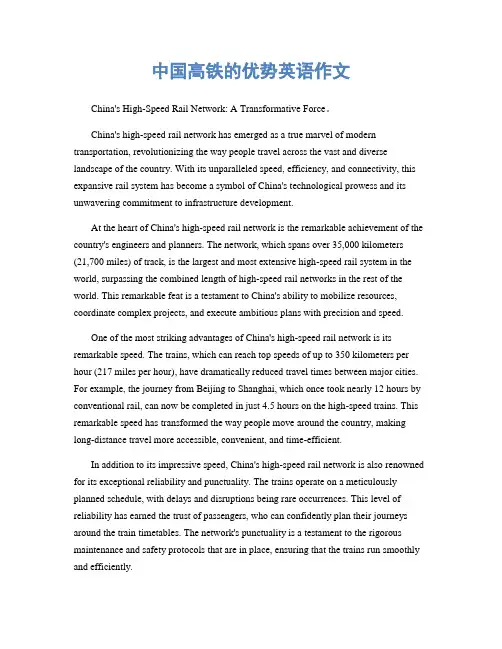
中国高铁的优势英语作文China's High-Speed Rail Network: A Transformative Force。
China's high-speed rail network has emerged as a true marvel of modern transportation, revolutionizing the way people travel across the vast and diverse landscape of the country. With its unparalleled speed, efficiency, and connectivity, this expansive rail system has become a symbol of China's technological prowess and its unwavering commitment to infrastructure development.At the heart of China's high-speed rail network is the remarkable achievement of the country's engineers and planners. The network, which spans over 35,000 kilometers (21,700 miles) of track, is the largest and most extensive high-speed rail system in the world, surpassing the combined length of high-speed rail networks in the rest of the world. This remarkable feat is a testament to China's ability to mobilize resources, coordinate complex projects, and execute ambitious plans with precision and speed.One of the most striking advantages of China's high-speed rail network is its remarkable speed. The trains, which can reach top speeds of up to 350 kilometers per hour (217 miles per hour), have dramatically reduced travel times between major cities. For example, the journey from Beijing to Shanghai, which once took nearly 12 hours by conventional rail, can now be completed in just 4.5 hours on the high-speed trains. This remarkable speed has transformed the way people move around the country, making long-distance travel more accessible, convenient, and time-efficient.In addition to its impressive speed, China's high-speed rail network is also renowned for its exceptional reliability and punctuality. The trains operate on a meticulously planned schedule, with delays and disruptions being rare occurrences. This level of reliability has earned the trust of passengers, who can confidently plan their journeys around the train timetables. The network's punctuality is a testament to the rigorous maintenance and safety protocols that are in place, ensuring that the trains run smoothly and efficiently.Another key advantage of China's high-speed rail network is its extensive coverage and connectivity. The network connects major cities, economic hubs, and tourist destinations, providing seamless transportation links across the country. This connectivity has had a profound impact on the economic and social development of the regions it serves. By facilitating the movement of people, goods, and ideas, the high-speed rail network has helped to bridge the gap between urban and rural areas, fostering greater integration and economic opportunities.Moreover, the environmental benefits of China's high-speed rail network cannot be overstated. Compared to air travel and traditional rail, high-speed trains have a significantly lower carbon footprint, making them a more sustainable mode of transportation. The network's efficient and eco-friendly operations have contributed to China's efforts to reduce its carbon emissions and combat climate change, aligning with the country's broader environmental goals.Beyond its practical advantages, China's high-speed rail network has also become a source of national pride and a symbol of the country's technological prowess. The network's impressive engineering feats, such as the construction of bridges and tunnels through challenging terrain, have captured the imagination of people around the world. The high-speed trains have become a source of fascination and admiration, as they represent the country's ability to push the boundaries of what is possible in transportation infrastructure.In conclusion, China's high-speed rail network is a remarkable achievement that has transformed the way people travel within the country. With its unparalleled speed, efficiency, connectivity, and environmental benefits, the network has become a true game-changer, shaping the future of transportation and contributing to China's overall economic and social development. As the network continues to expand and evolve, it will undoubtedly remain a source of national pride and a testament to China's engineering prowess and its commitment to building a better, more connected world.。
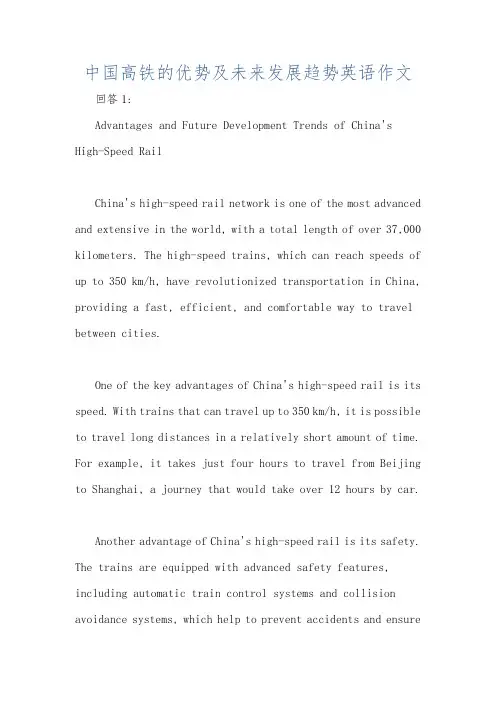
中国高铁的优势及未来发展趋势英语作文回答1:Advantages and Future Development Trends of China'sHigh-Speed RailChina's high-speed rail network is one of the most advanced and extensive in the world, with a total length of over 37,000 kilometers. The high-speed trains, which can reach speeds of up to 350 km/h, have revolutionized transportation in China, providing a fast, efficient, and comfortable way to travel between cities.One of the key advantages of China's high-speed rail is its speed. With trains that can travel up to 350 km/h, it is possible to travel long distances in a relatively short amount of time. For example, it takes just four hours to travel from Beijing to Shanghai, a journey that would take over 12 hours by car.Another advantage of China's high-speed rail is its safety. The trains are equipped with advanced safety features, including automatic train control systems and collision avoidance systems, which help to prevent accidents and ensurethe safety of passengers.In addition to these advantages, China's high-speed rail network is also environmentally friendly. The trains are powered by electricity, which produces fewer greenhouse gas emissions than traditional fossil fuels. This makes high-speed rail a more sustainable and eco-friendly option for transportation.Looking to the future, China's high-speed rail network is set to continue expanding. The government has announced plans to increase the length of the network to over 45,000 kilometers by 2035, connecting even more cities and regions across the country. Additionally, there are plans to develop even faster trains, with speeds of up to 600 km/h, which will further reduce travel times and increase the network's competitiveness.中国高铁的优势及未来发展趋势中国的高速铁路网络是世界上最先进和最广泛的之一,总里程超过37000公里。
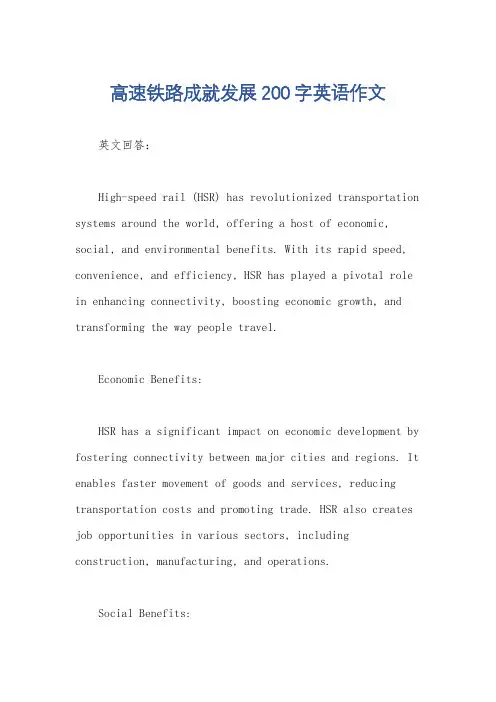
高速铁路成就发展200字英语作文英文回答:High-speed rail (HSR) has revolutionized transportation systems around the world, offering a host of economic, social, and environmental benefits. With its rapid speed, convenience, and efficiency, HSR has played a pivotal role in enhancing connectivity, boosting economic growth, and transforming the way people travel.Economic Benefits:HSR has a significant impact on economic development by fostering connectivity between major cities and regions. It enables faster movement of goods and services, reducing transportation costs and promoting trade. HSR also creates job opportunities in various sectors, including construction, manufacturing, and operations.Social Benefits:HSR enhances mobility and accessibility for commuters and business travelers. By reducing travel times, it liberates time for productive activities, leisure, and family time. HSR also improves access to educational and healthcare services, fostering social equity.Environmental Benefits:HSR offers significant environmental advantages compared to traditional modes of transportation. It operates on electricity, reducing carbon emissions and air pollution. Additionally, HSR reduces traffic congestion on roads and airports, leading to lower environmental impact.Technological Advancements:HSR has spurred advancements in transportation technologies. The development of high-speed trains requires cutting-edge engineering and innovation. These advancements have not only enhanced HSR but have also influenced other rail transportation systems.Future Prospects:The future of HSR is promising, with continued technological advancements and expansion plans. New lines are being built to connect more cities and regions. HSR is also being integrated with other transportation modes, such as airports and urban rail systems, to create seamless multimodal transportation networks.中文回答:高铁给现代社会的经济、社会和环境各方面带来了深刻变化。
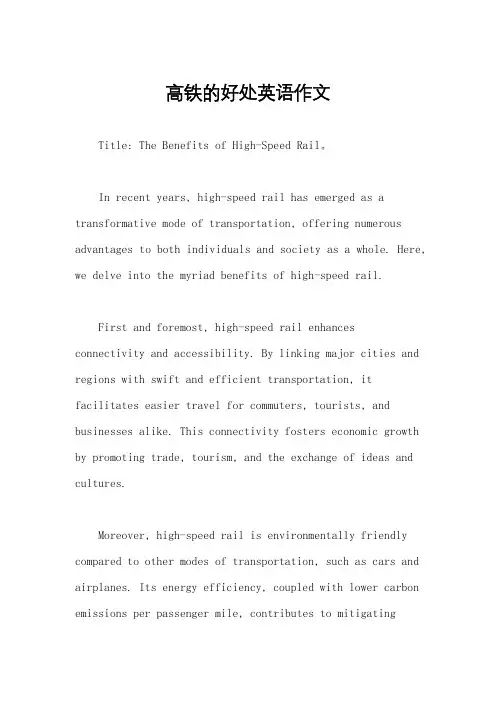
高铁的好处英语作文Title: The Benefits of High-Speed Rail。
In recent years, high-speed rail has emerged as a transformative mode of transportation, offering numerous advantages to both individuals and society as a whole. Here, we delve into the myriad benefits of high-speed rail.First and foremost, high-speed rail enhancesconnectivity and accessibility. By linking major cities and regions with swift and efficient transportation, it facilitates easier travel for commuters, tourists, and businesses alike. This connectivity fosters economic growth by promoting trade, tourism, and the exchange of ideas and cultures.Moreover, high-speed rail is environmentally friendly compared to other modes of transportation, such as cars and airplanes. Its energy efficiency, coupled with lower carbon emissions per passenger mile, contributes to mitigatingclimate change and reducing air pollution. As societies worldwide strive to transition to sustainabletransportation systems, high-speed rail emerges as a vital component in achieving these goals.Another significant benefit of high-speed rail is its capacity to alleviate traffic congestion and reducereliance on automobiles. By providing an attractive alternative for intercity travel, it reduces the number of cars on the road, thereby easing congestion and lowering the environmental and economic costs associated withtraffic jams.Furthermore, high-speed rail enhances safety and reliability. With dedicated tracks and advanced signaling systems, it significantly reduces the risk of accidents compared to traditional rail or road transportation. Additionally, the predictability and punctuality of high-speed rail services make it a dependable mode of travel for passengers, fostering trust and confidence in the system.Economically, investments in high-speed railinfrastructure stimulate job creation and economic development. Construction projects create employment opportunities in various sectors, from engineering and construction to manufacturing and services. Moreover, the improved connectivity provided by high-speed rail attracts businesses, stimulates investment, and enhances the competitiveness of regions served by the network.High-speed rail also promotes social equity by providing affordable and accessible transportation options for a diverse range of passengers. Unlike air travel, which can be prohibitively expensive for many individuals, high-speed rail offers competitive fares and greater accessibility, ensuring that transportation remains inclusive and equitable for all members of society.Additionally, high-speed rail contributes to the revitalization of urban areas and the development of secondary cities along its routes. By facilitatingefficient travel between metropolitan centers and smaller cities, it disperses economic activity, reduces urban sprawl, and promotes balanced regional development.In summary, high-speed rail offers a multitude of benefits, ranging from enhanced connectivity and sustainability to economic growth and social equity. As governments and policymakers continue to prioritize investments in transportation infrastructure, high-speed rail stands out as a pivotal solution for addressing the challenges of the 21st century and creating a more interconnected and sustainable world.。

高铁的好处英语作文The Benefits of High-Speed Rail。
High-speed rail, also known as bullet trains, has become increasingly popular in many countries around the world. It offers a fast, efficient, and convenient mode of transportation for both passengers and goods. There are several benefits to high-speed rail that make it an attractive option for travel and transportation.First and foremost, high-speed rail offers unparalleled speed and efficiency. With speeds reaching up to 300 kilometers per hour, high-speed trains can cover long distances in a fraction of the time it would take by car or conventional train. This allows passengers to save time and arrive at their destination more quickly, making high-speed rail an ideal choice for business travelers and tourists alike.In addition to speed, high-speed rail also offers a high level of comfort and convenience. The trains are equipped with modern amenities such as spacious seating, onboard Wi-Fi, and dining facilities, making the journey a pleasant and enjoyable experience. Passengers can relax and work during the journey, without the stress of driving or navigating through traffic.Furthermore, high-speed rail is also environmentally friendly. Compared to cars and airplanes, trains produce lower carbon emissions and consume less energy per passenger, making them a more sustainable mode of transportation. By choosing high-speed rail over other forms of travel, individuals can reduce their carbon footprint and contribute to a cleaner, greener environment.Another benefit of high-speed rail is its impact on economic development. The construction and operation of high-speed rail systems create jobs and stimulate economic growth in the regions they serve. By connecting cities and regions, high-speed rail facilitates trade, tourism, and business activities, driving economic development and prosperity.Moreover, high-speed rail can also help alleviate traffic congestion and reduce the need for new highways and airports. By providing a fast and efficient alternative to driving and flying, high-speed rail can help reduce the number of cars on the road and ease the burden on existing transportation infrastructure. This can lead to improved air quality, less road accidents, and a more sustainable urban environment.In conclusion, high-speed rail offers a wide range of benefits, including speed, comfort, environmental sustainability, economic development, and reduced traffic congestion. As the demand for fast and efficient transportation continues to grow, high-speed rail is poised to play an increasingly important role in meeting the needs of travelers and shippers around the world. With ongoing investment and expansion, high-speed rail has the potential to transform the way we travel and contribute to a more sustainable and prosperous future.。
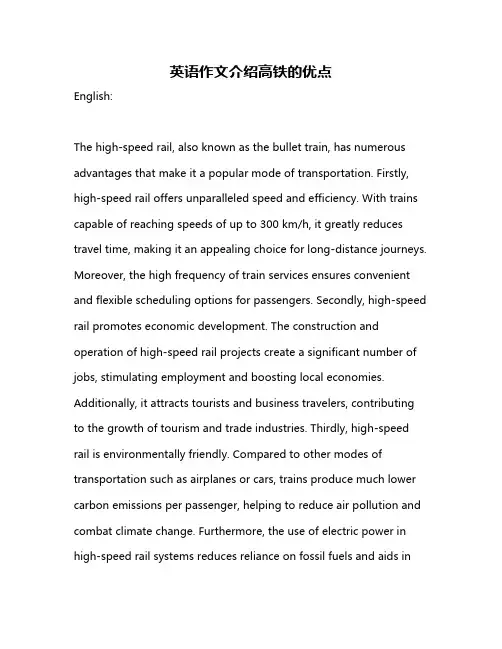
英语作文介绍高铁的优点English:The high-speed rail, also known as the bullet train, has numerous advantages that make it a popular mode of transportation. Firstly, high-speed rail offers unparalleled speed and efficiency. With trains capable of reaching speeds of up to 300 km/h, it greatly reduces travel time, making it an appealing choice for long-distance journeys. Moreover, the high frequency of train services ensures convenient and flexible scheduling options for passengers. Secondly, high-speed rail promotes economic development. The construction and operation of high-speed rail projects create a significant number of jobs, stimulating employment and boosting local economies. Additionally, it attracts tourists and business travelers, contributing to the growth of tourism and trade industries. Thirdly, high-speed rail is environmentally friendly. Compared to other modes of transportation such as airplanes or cars, trains produce much lower carbon emissions per passenger, helping to reduce air pollution and combat climate change. Furthermore, the use of electric power in high-speed rail systems reduces reliance on fossil fuels and aids inthe transition towards clean energy. Lastly, high-speed rail enhances connectivity and integration. It connects cities, regions, and even countries, facilitating the movement of people and goods between different locations. This improves social interactions, enhances cultural exchange, and promotes regional development and cohesion. In conclusion, the high-speed rail offers remarkable benefits in terms of speed, economic development, environmental sustainability, and connectivity, making it a favored choice for modern transportation needs.中文翻译:高铁,又称为动车,具备多项优势,使其成为一种受欢迎的交通方式。
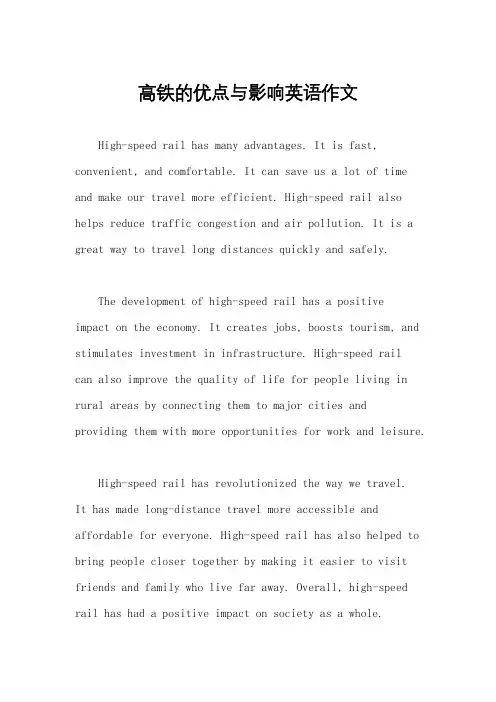
高铁的优点与影响英语作文 High-speed rail has many advantages. It is fast, convenient, and comfortable. It can save us a lot of time and make our travel more efficient. High-speed rail also helps reduce traffic congestion and air pollution. It is a great way to travel long distances quickly and safely.
The development of high-speed rail has a positive impact on the economy. It creates jobs, boosts tourism, and stimulates investment in infrastructure. High-speed rail can also improve the quality of life for people living in rural areas by connecting them to major cities and providing them with more opportunities for work and leisure.
High-speed rail has revolutionized the way we travel. It has made long-distance travel more accessible and affordable for everyone. High-speed rail has also helped to bring people closer together by making it easier to visit friends and family who live far away. Overall, high-speed rail has had a positive impact on society as a whole.
中国高铁的优势英语作文{z}Title: The Advantages of China"s High-speed RailChina"s high-speed rail, known as the CRH (China Railways High-speed), has become a symbol of the country"s technological advancement and development.With one of the longest and most extensive high-speed rail networks in the world, China"s high-speed rail offers numerous advantages that have transformed travel and transportation in the country.Firstly, China"s high-speed rail provides a fast, convenient, and comfortable mode of transportation.The trains operate at high speeds, reaching up to 350 kilometers per hour, reducing travel time significantly.This efficiency is particularly beneficial for intercity travel, allowing people to commute between cities quickly and efficiently.The high-speed rail stations are also well-equipped with modern facilities, such as escalators, elevators, and information systems, making the travel experience more convenient and comfortable for passengers.Secondly, China"s high-speed rail is an environmentally friendly mode of transportation.Unlike airplanes or cars, high-speed trains consume less energy and emit fewer carbon emissions.This makes them a greener option for transportation, contributing to the country"s efforts in reducing carbon emissions and addressing climate change.Thirdly, China"s high-speed rail promotes economic developmentand regional integration.The high-speed rail network connects major cities and regions, facilitating the movement of people and goods.This integration has led to the development of economic corridors along the rail lines, promoting trade, investment, and tourism.The high-speed rail has also helped to bridge the gap between urban and rural areas, improving the living standards and opportunities for people in rural areas.Fourthly, China"s high-speed rail has contributed to the development of related industries.The manufacturing, construction, and maintenance of high-speed trains and infrastructure have created job opportunities and stimulated economic growth.Additionally, the research and development of high-speed rail technology have led to advancements in aerospace, materials science, and other fields.Lastly, China"s high-speed rail showcases the country"s technological capabilities and innovation.The CRH trains are designed and manufactured in China, with many of the technologies and components developed domestically.This has helped to build the country"s reputation as a leader in high-tech industries and has inspired other countries to invest in high-speed rail development.In conclusion, China"s high-speed rail offers numerous advantages, including fast and convenient transportation, environmental friendliness, economic development, industry growth, and technological innovation.Its success has not only transformed travel and transportationin China but also set an example for other countries looking to develop their high-speed rail networks.。
高铁的好处英语作文The Benefits of High-Speed Rail。
High-speed rail, also known as bullet train, is a mode of transportation that uses trains capable of reaching speeds of 250 km/h or more. In recent years, high-speedrail has become increasingly popular around the world due to its many benefits. In this essay, I will discuss some of the advantages of high-speed rail.Firstly, high-speed rail is much faster than other modes of transportation. It can cover long distances in a short amount of time, making it ideal for businesstravelers who need to get to their destination quickly. For example, a journey from Beijing to Shanghai by high-speed rail takes only 4 hours, compared to 12 hours by car or 2 hours by plane, including time spent checking in and waiting for the flight.Secondly, high-speed rail is more environmentallyfriendly than other modes of transportation. It producesless greenhouse gas emissions per passenger than cars or planes, making it a more sustainable option for long distance travel. In addition, high-speed rail uses lessland than highways and airports, which can help to preserve natural habitats and reduce urban sprawl.Thirdly, high-speed rail can boost economic development. It creates jobs in construction, manufacturing, and maintenance, and can also stimulate tourism and business activity in the regions it serves. For example, the high-speed rail line between Madrid and Barcelona in Spain has helped to increase tourism and business activity in both cities.Finally, high-speed rail can improve the quality oflife for people who live in cities along its routes. It can reduce traffic congestion and air pollution, and make it easier for people to travel for work, education, and leisure. In addition, high-speed rail stations can become hubs for urban development, attracting businesses and housing to the surrounding areas.In conclusion, high-speed rail has many benefits, including speed, environmental sustainability, economic development, and improved quality of life. As more countries invest in high-speed rail networks, it is likely that these benefits will continue to grow.。
精品资料 欢迎下载
It is a really hot topic now as many city had opened
high-speed railway. Many people said that high-speed
railway is much better than the other transportation.and as
also some people believe that it is no future .to my point of
view ,high-speed railway bring us real convenient .
My reasons are as follows:
First ,the stations of the high-speed railway are much
closer to our living area ,like buses.and it is much more
convenient to transport goods.for example ,a businessman
in Shanghai want go to Sichuan with 1000kg goods,if he
go to Sichuan by plane ,he need go to suburbs because
the airports always in the suburbs, and it cost much money
to checked the goods. if he go by train ,he need to go to
the railway station far away from home ,and the train take
much more time .and if he take bus,though it is convenient,
it not only cost much money ,but also waste much time.
Secondly,the most important disadvantage of
high-speed railway is that it need a great number of
passengers .As the second most populous countries of the
world, Chinese has no pressure.
精品资料 欢迎下载
What's more ,China is developing in a "high
speed",even though high-speed railway cost much money ,
I believe China can hold it .
As all above ,I firmly believe that the future of
high-speed railway is shinning!